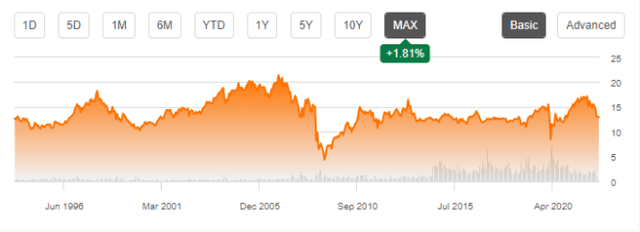jaturonoofer/iStock via Getty Images
RFI strategy and portfolio
The Cohen & Steers Total Return Realty Fund (NYSE:RFI) is a closed-end fund whose objective is “to achieve a high total return through investment in real estate securities”. It may invest in common stocks, preferred stocks and other equity securities issued by real estate companies, including REITs. It was launched in 1993, has 176 holdings, and a distribution rate of 7.36%. The expense ratio of 0.89% is quite low in the closed-end fund universe. It is leveraged by less than 2%. The normal monthly distribution is $0.08, unchanged since 2016, with some exceptional distributions. RFI has paid quarterly distributions from January 2009 to September 2016, then resumed monthly payments.
As described in the prospectus by Cohen & Steers, the fund intends to maintain diversification among property sectors, geographic regions and individual companies. It also tries to maintain a low level of portfolio volatility compared to the stock market. Investment selection criteria include “standards with regard to the company’s organizational and management depth, property quality, track record of profitability, balance sheet strength, access to capital markets, financial leverage and growth potential”.
The next table lists the top ten holdings on 3/31/2022, representing about 47% of asset value. The portfolio has an exposure superior to 5% to each of the top 3 holdings.
|
Ticker |
Name |
Weight% |
Sector |
|
American Tower Corporation |
9.0 |
Infrastructure |
|
|
Prologis Inc. |
6.1 |
Industrial |
|
|
Public Storage |
5.6 |
Self Storage |
|
|
Welltower Inc. |
4.8 |
Health Care |
|
|
Invitation Homes Inc |
4.4 |
Single Family Homes |
|
|
Simon Property Group Inc. |
3.9 |
Regional Mall |
|
|
Duke Realty Corporation |
3.9 |
Industrial |
|
|
Extra Space Storage Inc. |
3.5 |
Self Storage |
|
|
Equinix Inc. |
3.0 |
Data Centers |
|
|
Crown Castle International Corp. |
3.0 |
Infrastructure |
Past performance
Since January 2005, RFI has lagged the Vanguard Real Estate Index Fund (VNQ) by about 20 percentage points in total return. The annualized difference is not very significant: 39 bps. Risk metrics are similar for both funds (maximum drawdown and volatility).
|
since 2005 |
Total Return |
Annual Return |
Drawdown |
Sharpe ratio |
Volatility |
|
RFI |
202.00% |
6.54% |
-74.03% |
0.38 |
23.76% |
|
VNQ |
221.62% |
6.93% |
-73.77% |
0.42 |
22.64% |
Data calculated with Portfolio123
Unlike most high yield funds, the share price doesn’t show any decay pattern (neither growth).
RFI share price (Chart by TradingView on Seeking Alpha)
Securities with yields above 6% suffer from capital decay on average. There are rare exceptions, RFI is one of them. The 10-year average annualized return including dividends of all ETFs with a yield superior to 6% is 4.5%, for an average yield of 8.8%. The 10-year average annualized return including dividends of all Russell 1000 stocks with a dividend yield superior to 6% is 5.9%, for an average yield of 8% (data calculated with Portfolio123).
RFI has not suffered from distribution decay either: it was already $0.08 per month in 1993 (with variations in between).
How to fight inflation with RFI
RFI is very close to its initial share price and distribution almost 30 years ago. In the high yield universe, this is an excellent performance. After tax and adjusted for a rising inflation, it’s a bit less attractive. My strategy Real Estate Rotation is based on a paired switching model, usually invested either in RFI, or in the Cohen & Steers Quality Income Realty Fund (RQI). They have quite similar portfolios: as of writing, about 81% in stocks of U.S. real estate companies, about 10% in hybrid assets (convertible bonds and preferred stocks in real estate), the rest in bonds and cash equivalents. Holdings and weights are not identical, but these two funds’ net asset values are highly correlated. RQI and RFI have different leveraging factors (about 1.2 and 1.0, respectively) and different premium/discount histories. Every few weeks, I use a proprietary formula based on 5 factors to invest in the fund with better potential. I sometimes pick an ETF when none of the CEFs looks attractive. I have been investing in this strategy since November 2020, and publishing it in Quantitative Risk and Value since August 2021.
The next table reports my trades since August 2021. The last line is my current position (on 6/14/2022). The P/L columns report capital profits and losses (dividends are not accounted).
|
Ticker |
Buy date |
Bought@ |
Sell date |
Sold@ |
Current@ |
Trade P/L |
Compounded P/L |
|
RFI |
8/2/2021 |
16.05 |
8/30/2021 |
16.4 |
2.18% |
2.18% |
|
|
RQI |
8/30/2021 |
15.9 |
1/3/2022 |
18.2 |
14.47% |
16.96% |
|
|
XLRE |
1/3/2022 |
51.33 |
1/31/2022 |
46.98 |
-8.47% |
7.05% |
|
|
RQI |
1/31/2022 |
16.43 |
4/4/2022 |
16.89 |
2.80% |
10.05% |
|
|
RFI |
4/4/2022 |
15.69 |
5/9/2022 |
15 |
-4.40% |
5.21% |
|
|
RQI |
5/9/2022 |
14.3 |
6/6/2022 |
14.81 |
3.57% |
8.96% |
|
|
RFI |
6/6/2022 |
14.37 |
12.88 |
-10.37% |
-2.34% |
My trades are traceable in QRV post history (trial is free).
As of writing, the strategy has a capital loss about -2.3% since August. It is slightly in gain including dividends. At first sight, it doesn’t look great. However, in the same time, the 3 instruments I have used are in deeper losses:
|
Fund |
XLRE |
RFI |
RQI |
|
P/L since 8/2021 |
-16.14% |
-19.60% |
-19.84% |
(Dividends are not included either)
On this 10-month period, the Real Estate Rotation had an excess P/L of 13.8% to 17.5% over “buy-and-hold”. The usual disclaimer says that past performance is not a guarantee of future return. I go farther: Real Estate Rotation is unlikely to bring a 2-digit excess return in a less volatile 10-month period. However, I think this rotation is a better protection against erosion and inflation on the long-term than “buy-and-hold”.
Takeaway
RFI holds 176 securities related to real estate with an objective of total return. Unlike most funds with a 6%+ distribution yield, it has been able to avoid decay in capital and income stream. A rotational strategy with RQI and an index ETF may help go one step further to fight inflation.


Be the first to comment